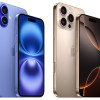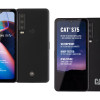CTIA Wireless 2004
Samsung announced a good number of new phones at CTIA this year. Some of the phones had made appearances at previous shows, but not been announced in a press release. Most of the announced phones are still technically in "preview" status; Samsung likes to emphasize that everything is tentative until a phone is formally launched by a specific carrier.
One of the most notable phones is the SGH-P735, Samsung's first megaixel camera phone for the U.S. It's essentially the same as the European SGH-P730 announced last week at CeBIT.
Also announced was the SGH-D415, which is the U.S. version of the SGH-D410. The key features are the large 262,000-color display, sliding form factor, and swivel camera. The sliding mechanism is spring-loaded so it "snaps" open and shut easily. The D415 is also Samsung's first phone for the U.S. with 64-chord polyphonic ringtones.
Next is the A680, a CDMA phone with video camera, flash, and dual color displays. It's very small and light - the smallest video camera phone to date, according to Samsung.
Anyone who was a fan of Samsung's popular A500 will definitely like the A680. It's essentially the same form factor, but smaller, thinner, lighter, and with twice the features.
The SGH-E316 (and SGH-E317) are also clamshell camera phones with dual color displays, but for GSM networks.
The SGH-i505 is Samsung's new GSM PalmOS phone. It's slightly larger than the SPH-i500, but adds a VGA camera and the nifty twisting display mechanism. The twisting display concept is especially useful in a PDA phone like this, since it allows the phone to function just like a normal clamshell, but also convert into a tablet form just like a regular PDA.
Next up is the SCH-A690, Samsung's first Push-To-Talk phone. Highlights include a color display, rugged design, and speakerphone.
One of the biggest announcements was the SCH-A790, Samsung's first dual-technology CDMA / GSM phone. This very stylish clamshell phone boasts dual color displays, including a beautiful 260,000-color main display, and a VGA camera with flash.
GPRS isn't included, so features like MMS and WAP will only work in CDMA mode. The camera will still function in GSM mode, but photos can only be sent in CDMA areas.
Like the Motorola A840, (also announced this week,) the GSM mode only supports European frequencies. The idea behind this type of phone is to allow CDMA users to roam overseas, not to use domestic GSM networks.
Although not officially announced, Samsung was showing off its 2nd-generation CDMA clamshell Palm OS device - the i550. It's important to stress that this phone is still under development and pretty much everything is subject to change. It won't be released until 4th quarter at the earliest.
Still, if even a fraction of the features make it to the final version, it would still be a mighty impressive PDA phone. Leading the feature list are Palm OS 5.2, a megapixel camera with flash, video recording, an SD card slot with SDIO support, voice recognition, and audio/video playback with dedicated control buttons on the outside.
Most impressive, however, are the displays. Specs weren't available, but the main display is high-resolution and looks fantastic. The outer display is a unique hybrid OLED display. The top part is a blue status and time display, while the bottom part is a relatively large, full-color OLED. It appears to be all one display module, similar to old black and white LCDs that had a dedicated icon row at the top. The hybrid design allows just the full-color part to go dark when idle, presumably saving power compared to an all-color display.
Finally, Samsung was presenting the world's first live demonstrations of a complete, end-to-end CDMA 1xEV-DV system. Prototype EV-DV phones were on hand, showing live video streaming and live video calling. The video streaming worked very well and was very smooth.
The close-up photo below shows a live video call. The main image is me, which is coming from the other phone, being held by the guy next to me. The inset image (bottom-right) is also me, from the phone I'm using - it's the image being streamed to the other phone.
The video calling image was a bit jerky due to a low frame rate, although that's a limitation of the EV-DV Release C standard - the version being shown here.
EV-DV Release D will boost the uplink speed dramatically, permitting much better framerates for video calling. Samsung expects to have a prototype Release D system ready in about 6-8 months.









































 iPhone 14 Plus Offers a Big Screen For Less
iPhone 14 Plus Offers a Big Screen For Less
 iPhone 16 Brings More Features to All Price Points, Including New Camera Control
iPhone 16 Brings More Features to All Price Points, Including New Camera Control
 Motorola's new Edge Offers a Lot for $500
Motorola's new Edge Offers a Lot for $500
 Bullitt Announces First Phones with Satellite Messaging
Bullitt Announces First Phones with Satellite Messaging
 Foldable Google Pixel Confirmed by FCC
Foldable Google Pixel Confirmed by FCC







